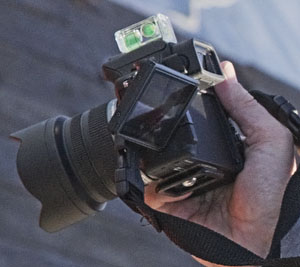considering the G1 screen pops around the back to allow you to use it as a point n shoot (like my wife prefers) and given the bulkiness of the EP-2 pop on the flash shoe affair I am not sure I see the difference?
this is not meant to be a "smarty pants" question, but I'm genuinely interested. In a shop recently my wife didn't like the GF or EP-1 because it didn't have the grip that the G1 has (and her Canon powershot has a small grip).
especially when you say:
I wanted something I can hang from a backpack harness loop or preferably slip into a side netting, the G1 doesn't really do that with the kit zoom, so is that what did it? Its one of the reasons (DoF and simplicity being among the others) that I am looking carfully at the 20f1.7
As I mentioned earlier, I simply didn't want another DSLR look-a-like, no matter how small, I recently sold my E-410 for that reason. I really liked the LX2, but found the body too small and the lack of lens versatility a shortfall, though it does get a fair bit of use even now. The Pen fit the bill perfectly and the GF1 would have done so as well, but it just came out too late for me.
I didn't want a camera with a pop-up fash, as I've found them to be pretty much useless. Not being able to use an external flash when the EVF is attached to the Pen is a bit of a bummer, but I suspect there'll be a solution to this in good time. For example, it could easily be implemented with an offset viewfinder with a hotshoe.
I'm very familiar with the Olympus menu system and find the super control menu one of the easiest thing to work with, so that wasn't an issue for me. And I guess the fact that all of my Olympus lenses will work with the Pen was a bonus. That said, I don't use them that often, as I prefer my M mount lenses. The in-body IS works really well here, as I can handhold even my Nikon 300mm (OK, it's not M mount) when using the Pen and the Pen 2 EVF has elevated things to a new level.
I'm not concerned that the Pen isn't pocketable like the LX2, but what I really like is that it doesn't scream out and scare people like my E3 and 14-35mm, for example. It's also far more easy to cart around. That's where the travelling bit on planes comes into it as well; I can toss just about my entire kit into a small carry-on case that has everything that I need, including clothes for a few days etc.
I guess the fact that Panasonic came out first means that there are more Panasonic users out there and the fact that the Pen got a poor report in reviews about it's AF performance, even though I think it was somewhat over-blown, increased the sales of Panasonic m4/3s cameras. Also, I think that existing Panasonic users were hungering for a new camera, since Panasonic more or less abandoned 4/3s in 2007, so the excitement of Panasonic owners probably exceeds that of Olympus owners, who have been able to keep updating on a constant basis.
I'm by no means putting down Panasonic gear, I reckon it's great, but I've observed both here and that other place (DPR) that there seems to be more of an us and them relationship between Olympus and Panasonic owners, much like between Canon/Nikon owners, rather than mutual bonding in adversity. By adversity, I mean the constant put downs by other brand owners of the m4/3s system (another solution looking for a probem?), until their brand/s comes up with a suitable answer.

Cheers
Ray






